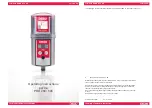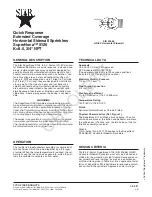
D. Install the R.O. Membrane
The RO Membrane has been shipped to you in a spe-
cial preservative. Unscrew the tubing from the end-
cap of the membrane housing. Then unscrew the
end cap from the membrane housing on the appli-
ance, insert the membrane as illustrated below. The
O-rings on the product water tube of the membrane
MUST FULLY SEAT in the membrane housing for
proper operation. Also make sure that the Brine
Seal on the membrane seals with no gaps or wrin-
kles inside the membrane housing. Once the mem-
brane is installed, replace the end cap and reconnect
the tubing.
To insure that all the special preservative is flushed
from the system before use, DO NOT use the first
two tankfuls of water produced by the system.
F. Make Initial Tubing Connections
It is advantageous to make some of the tubing con nec -
tions at this time, since the undersink work area is not
so cramped and access to the com po nents is easier.
G. Install the Purification Assembly and
Storage Assembly
The purification assembly is usually mounted to the
right or left sink cabinet sidewall, taking into con -
sid er ation the space available and the tank lo ca tion.
Generally, the tank is placed in the rear of the
cabinet while the pu
ri fi ca tion assembly is posi-
tioned toward the front for cartridge ac ces si bil i ty.
To mount the purification assembly elevate at least
2" off the cabinet floor and, while keeping level,
mark the lo ca tion of the mounting holes on cabinet
sidewall. Make small pilot holes with an awl or drill
and screw in the two mounting screws, leaving just
enough pro trud ing to allow bracket mounting slots
to slide over them.
NOTE: If the cabinet sidewalls are not of solid
con struc tion, the purification assembly can be set
on the cabinet floor and held against the sidewall
with the mounting screws.
The tank may be oriented either vertically or hor i -
zon tal ly. It is generally placed to the rear of the cab-
inet but can be set in the front center (between the
sink basins) for ease of access if space permits.
H. Make Final Tubing Con nec tions
With all of the components in place, the final tubing
connections can be made. When routing tubing
between components, several guidelines should be
ob served.
• Tubing runs should generally follow the con-
tour of the cabinets rather than interfere with
the cab i net storage area.
• Strive for neatness and an orderly tubing “flow”
using fasteners (e.g. insulated staples) to secure
the tubing. Cut tubing to the desired length.
• Arrange the tubing so there are no sharp bends
and leave some “play” in the tubing for ease of
ser vic ing.
• Try to keep the tubing from the purification as -
sem bly to the tank and faucet as short as prac -
ti cal for good flow.
I. Install Ice Maker Hookup (optional)
Note: Check with refridgerator manufacturer for
compatibility with your refridgerator model.
The RO drinking water appliance can be con nect ed
to any standard refrigerator ice maker or ice
maker/water dispenser. It should never be
connected to a com mer cial type bar ice maker.
Hooking up an ice maker involves connecting a tee
with shut off valve into the faucet tubing and rout-
ing tubing over to the refrigerator.
Do not
hook-up
to existing copper tubing.
Before turning off the existing tap water sup ply to a
refrigerator ice maker, always shut off the ice maker
first (usually by lifting the lever arm above the bin
to the up per most position). The ice maker should
only be turned on again after the RO system has
been drained several times and the tank has a full
supply of water.
NOTE: Before any service is performed on the RO
system, always turn off ice maker valve and the ice
maker unit. Only turn on when system is operat-
ing and tank is full.
J. Start Up the System
1) Double check that all connections are secure.
2) Turn on feed water valve and check for leaks.
If any leaks are noted, turn off valve and
correct before pro ceed ing.
3) Turn on storage tank valve and open faucet
until a steady stream of water flows. Close
faucet, wait at least 5 minutes and carefully
check for leaks. Cor rect as nec es sary.
Summary of Contents for OmniRO
Page 1: ...Drinking Water Systems Reverse Osmosis Installation Manual...
Page 12: ......






























